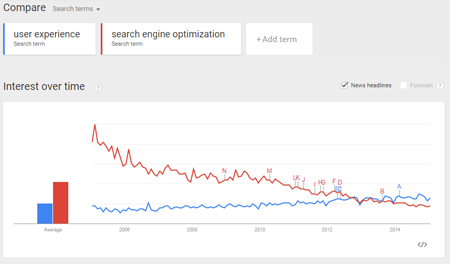
Then it sat with whichever part of marketing is also handling search engine optimization – this made more sense than IT, because those types of marketers can actually act on the data. And indeed, many of companies still structure teams that way today – driving organic traffic to web sites remains one of the core duties of digital teams, and there is a natural synergy between SEO and web analytics.
That structure is effective, but limited. There are two searches that really demonstrate why:
Google Trends shows user experience searches picking up.
Since 2005, user experience and usability have started becoming as important to some companies as getting traffic from search engines. That’s something companies are continuing to balance today, but it’s not nearly as lopsided as it was 10 years ago. If you think about it as the online optimization model of acquisition, conversion, and retention, SEO is the first stage, and usability/conversions are the latter two:
Like SEO teams, usability and user experience teams have a natural synergy with web analytics too – UX improvements are only ever real if they show observable benefits to the business or to the user. Regardless of where you run web analytics from, web analytics should have just as much weight in solving for usability and conversion issues as it does with search-related ones.
Here are some practical ways to combine old school usability and conversion tweaks with analytics fundamentals:
Split Testing Scarcity and Menu Recognition
Scarcity is something that we’ve covered in the past.
- Used truthfully and sparingly, it can lead to a nice boost in conversions, and accurate messaging for the user.
- Abused, it can lead to distrust, and have visitors check your competitors instead.
In the early days, using scarcity was as obvious as making sure your buttons are recognizable as buttons, (ensuring your site has visual affordance) but now that it is a pretty common play, you might want to check if you’re getting your conversion returns for a scarcity play.
Menu recognition is also something that we tend to cover. To use the interface design parlance, having too much “chrome” or menus can eat up too much space on limited screen real estate, especially for smart phones. Too little chrome, though, and your site’s usability take a huge hit, with users unable to interact with your content.
For both scenarios, the split test is your friend. For the uninitiated, split tests allow you to take two versions of a page, serve them up to users for the same, and see which one achieves your goals better. Free tools like Google Analytics allow you to do this pretty quickly.
For scarcity, this means you could have versions with the time left on the offer stated and unstated, to see if scarcity is actually helping you sell more. For chrome recognition, you can check if you’re achieving the right balance on for both desktops and laptops by having a version with more obvious menus versus one where the menus are more subtle.
In both cases, there’s a practical analytics process to check for usability and conversion gains.
Bounce Rate Segmentation for Sources and Depth
Usability is rarely a clear-cut thing to observe for most sites – even when there are great metrics to observe the site with. Bounce rate is right up there with conversions and profits as one of the key metrics to watch, but even bounce rate can be misleading.
For bounce rate to be effective, it has to be used in context. There are two great groupings to start with: traffic sources, and depth.
Traffic Sources
One of the first things you should be doing when you’re setting up your analytics tool is setting up filters or segments for where your traffic is coming from. You can have more, but you should have at least three groups – people going to your site coming from search engines, other web sites, or social networks.
The idea is that if your bounce rate is high for people coming in from social networks, you’re fine. The tasks they are coming to your site for should not have a ton of intent associated with the click- they are there to satisfy a curiosity. If your bounce rate is high for people coming in from other sites, you’re not as fine, but you’re still not in that much trouble, usability-wise. The link from other web sites is a nice vote of confidence, but the tasks may not match.
If your bounce rate for organic searches is high, it’s time to research where you have serious usability issues. Searches come with a lot of intent, and a high bounce rate for organic traffic indicates you’re not fulfilling user tasks – you need to find the searches and areas where this happens the most, (this is doable, but not a trivial task given not provided) then fix the leaky bucket.
Depth or Area
Lowering bounce rate seems like a really romantic thing, at least as romantic as it gets in the online marketing world: fighting for that second click.
But the truth is that that second click is not always valuable.
- If you have a product page, visitors may get to that and find the specifications they need for a support question – even if they don’t click on anything else, you just solved a self-support issue. Same thing for FAQ pages.
- Even for top of the funnel type activities, bounce rate may not be a bad thing – many blogs, including this one, allow you to read the entire entry without ever clicking on anything after that first click from Google or Bing. If the visitor consumes the information and finds it valuable, that’s a win – although on your analytics tool, that still counts as a bounce.
Bounces are really bad if they indicate that a user gives up on navigating your site – and you can segment this. If visitors bounce when they view your home page, or a high level page intended for navigation, then you have usability issues.
Analytics and Usability Play Well Together
Analytics is a critical piece of the puzzle, whether the team managing web analytics sits with your IT, SEO, business intelligence, or usability teams. If you are working with a usability or a conversion team, it’s definitely a specialization you need to develop.


